Summary of previous results and annual simulations
We have conducted simulations on annual or monthly basis for various energy systems or hybrid combinations of such systems [see annual reports - a) yearly report on solar thermal - seasonal storage, b) report on yearly evaluation of hybrid combination of heat pump, solar collectors and storage tank, c) report on PV yearly evaluation, d) report on annual evaluation of wind energy]. We included a financial analysis in each case looking at the viability of the systems taking into account feed-in tariffs and renewable heat incentives. We also considered how some of the key parameters could affect the financial aspect of it in the future.
♦ Electricity demand:We have introduced an hourly demand calculated using excel.
♦ Domestic hot water (DHW): The demand was calculated using excel
♦ Preliminary work - Building design:: We have used ESP-r to model a low energy consumption dwelling using passive standard insulations and building components. We have conducted a detailed analysis of the influence of passive solar gains and obtained a good reduction of the heating demand by increasing glazing area facing south. We have evaluated the space heating and cooling demand per unit area for the dwelling. For further info see the ESP-r summary and the ESP-r analytical report
♦ Mechanical ventilation: Mechanical ventilation with heat recovery runs continuously to provide 0.3 ac/h. Simulations were done using ESP-r. Mechanical ventilation heat recovery systems are considered part of the hybrid energy system as they are using an active element (fan) to recover heat from exhaust to inlet ducts in order to preheat or pre cool fresh air introduced to a building thus reducing significantly the heating /cooling load. For further info see the ESP-r summary and the heat recovery background info.
♦ Solar water heating + HP: Heating demand We have evaluated the annual contribution of a hybrid combination of solar collectors and heat pump and decide to use a 2.8m2 evacuated tubes solar thermal system with a 5 kW GSHP.
♦ Thermal storage: We use a standard water tank to store heat from solar collector and provide DHW at 45°C. The temperature for DHW can be lowered to 45C by using UV-C light system to disinfect and prevent risks of legionella. The same temperature is adequate for space heating use using low temperature emitter such as under-floor heating. For further info see the report on yearly evaluation of hybrid combination of heat pump, solar collectors and storage tank We considered seasonal storage as well but concluded that it would be ineffective for our case-study. For further info see the yearly report on solar thermal - seasonal storage.
♦ Wind: We concluded that micro-wind would not work in Glasgow unless the dwelling was situated in an exceptionally well exposed rural site, which would not be representative of a standard case. The capacity factors were too small due to a relatively low average wind speed in Glasgow but also because in suburban environment the effective wind speed is further decreased due to the environment surrounding the turbine. For further info see the report on annual evaluation of wind energy.
♦ PV: We have obtained that PV panels could provide the adequate electricity demand required. The financial aspect of PV is greatly influenced by feed-in tariffs in place as well as potential future cost reductions. The total capacity we will use is 4.375 kWp (report on PV yearly evaluation)
♦ CHP / bio-fuel boilers: CHP was not considered as standard units mostly operating on gas which is a fossil fuel and this would not fit our objective to design a low-carbon dwelling using essentially renewable sources of energy. Bio-fuel boilers such as wood pellets would in many cases provide an excellent solution but due to regulations in most urban areas preventing the use of fuel creating smoke, we have not considered them.
Key parameters of HYBRID energy system
The HYBRID energy system used in Glasgow is the following one:
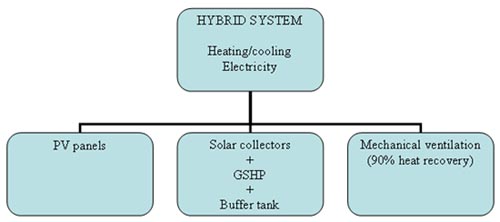
♦ The thermal demands, after taking into consideration the contribution of the ventilations are:
· Space heating = 1000.5 kWh
· Space cooling = 0 kWh
♦ PV: Type: monocrystalline PV module BP4175T produced by the BP Solar.
· Efficiency of module = 14%
· Dimensions = 1587mm * 790mm * 50mm
· Power output = 175Wp
· Capacity: 25 PV panels so we have a power output of 4.375kWp in order to cover our demand
· Total area = 31.3 m2
♦ Solar collectors: We have used a 30 tube solar panel - high efficiency double wall evacuated tube solar collector.
♦ GSHP: Type: KENSA Tl - Compact Single - 02
· Capacity = 5kW
· COP (average) = 3
♦ Water tank: Type: 500 x 1500 245 litre twin coil vented copper cylinder
· Capacity = 245 litres
· Storage T = 45C
♦ Mechanical Ventilation Heat Recovery: Type: Ventos 50 DC Stand-Alone Comfort Ventilation 'MVHR' Unit
· Capacity = 3 ac/h
· Consumption = 15W
Results
The following figure represents the summary of the demand versus generation
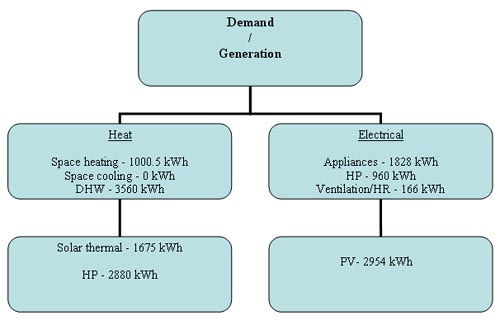
The graph below shows the electricity generation from the hybrid system. The simulations were done using HOMER on hourly basis. We have compiled monthly the electrical demand, the PV production, the deficit and surplus (all in kWh). Deficit is shown as negative numbers and surplus as positive numbers.
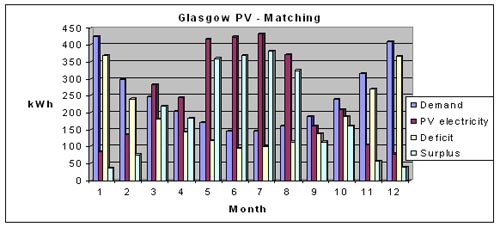
Due to the fact that only PV has been retained to generate renewable electricity we have a significant temporal mismatch when data is analysed hourly:
- The PV deficit is 2319 kWh or 78.5% of the yearly demand
- The PV surplus 2318 kWh or 78.5% of the PV production
As we are connected to the grid, this mismatch is not critical in terms of matching the demand through the periods of deficit, nor from the time of the surplus injection into the grid from the point of view of an individual dwelling as the generated surplus is small.It is interesting to compare the monthly calculation with hourly one. See the following graph:
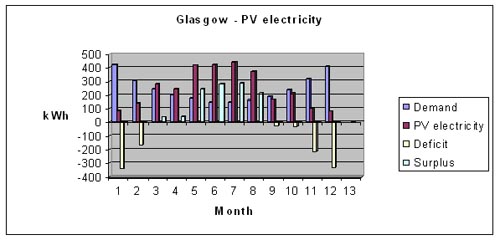
The same data calculated monthly shows quite different figures (annual deficits and surplus are respectively 1094kWh and 1092kWh)
Potential problem on large scale: We have seen above that 78% of electricity generated is not utilized on site at the time it is produced but re-injected into the grid.
Should a very large amount of dwellings be equipped in a similar manner it may be the case that during surplus periods the grid can receive then a large amount of electricity rapidly and need a scheme to predict and manage such situations with the rest of the grid gene The following graph represents the repartition of the heat generation. The exact figures are provided above.
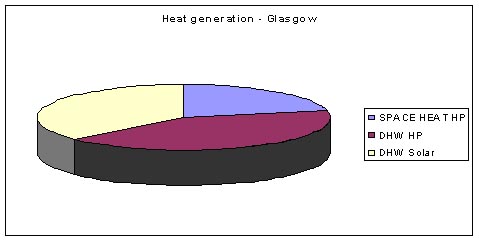
Conclusions
The results obtained for Glasgow can be summarised as follows:
- We succeeded in creating a low-carbon hybrid energy system which allows matching the thermal and electrical demands.
- The hybrid system includes
◊ Solar PV
◊ Solar collectors for water heating
◊ GSHP
◊ Mechanical ventilation (90% HR)
- Demand reduction measures allowed reducing heating demand to 8.2kWh/m2 and eliminating cooling demand.
- High efficiency heat recovery for the mechanical ventilation reduces heating demand by 76%.
- 50% augmentation of passive solar gains provides a 38% reduction of the heating demand.
- Cooling demand was eliminated using shading & natural ventilation.
- Electricity production by PV requires a large capacity of 4.35kWp due to low capacity factor of 6.9%
- Electricity demand and generation mismatch is large (78.5% of demand) and could be difficult to manage on larger scale.
- Careful architectural design of the dwelling allowed implementing a large PV capacity
- Small-wind could not provide enough electricity in the case considered
- Water heating using solar collectors covers 47% of needs. It allows reducing the heat load for the HP and therefore the electrical demand.
- Hybrid thermal was necessary as solar collectors cannot provide sufficient solar fraction in Glasgow using reasonable size collectors (within constraints of physical implementation).
- The thermal hybrid system uses a storage tank at low temperature = 45°C.
- Seasonal storage was not applicable because of the small solar heat surplus but also the long period between heat generation and subsequent requirement.
- The financial analysis reveals that feed-in tariffs and RHI are necessary to make renewable systems viable.
| 